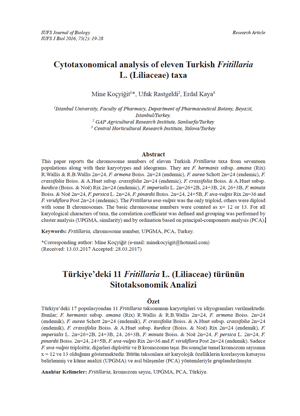NEWS 2017
Cytotaxonomical analysis of eleven Turkish Fritillaria L. (Liliaceae) taxa
Mine KOÇYIĞIT¹, Ufuk RASTGELDI², Erdal KAYA³,
IUFS Journal of Biology 75(2): 19-28 (2016)
http://dergipark.gov.tr/download/article-file/337040
¹Istanbul University, Faculty of Pharmacy, Department of Pharmaceutical Botany, Beyazit, Istanbul, Turkey.
²GAP Agricultural Research Institute, Sanlıurfa, Turkey
³Central Horticultural Research Institute, Yalova/Turkey
Abstract
This paper reports the chromosome numbers of eleven Turkish Fritillaria taxa from seventeen populations along with their karyotypes and ideograms. They are F. hermanis subsp. amana (Rix) R.Wallis & R.B.Wallis 2n=24, F. armena Boiss. 2n=24 (endemic), F. aurea Schott 2n=24 (endemic), F. crassifolia Boiss. & A.Huet subsp. crassifolia 2n=24 (endemic), F. crassifolia Boiss. & A.Huet subsp. kurdica (Boiss. & Noë) Rix 2n=24 (endemic), F. imperialis L. 2n=26+2B, 24+3B, 24, 26+3B, F. minuta Boiss. & Noë 2n=24, F. persica L. 2n=24, F. pinardii Boiss. 2n=24, 24+5B, F. uva-vulpis Rix 2n=36 and F. viridiflora Post 2n=24 (endemic). The Fritillaria uva-vulpis was the only triploid, others were diploid with some B chromosomes. The basic chromosome numbers were counted as x= 12 or 13. For all karyological characters of taxa, the correlation coefficient was defined and grouping was performed by cluster analysis (UPGMA, similarity) and by ordination based on principal-components analysis (PCA).




